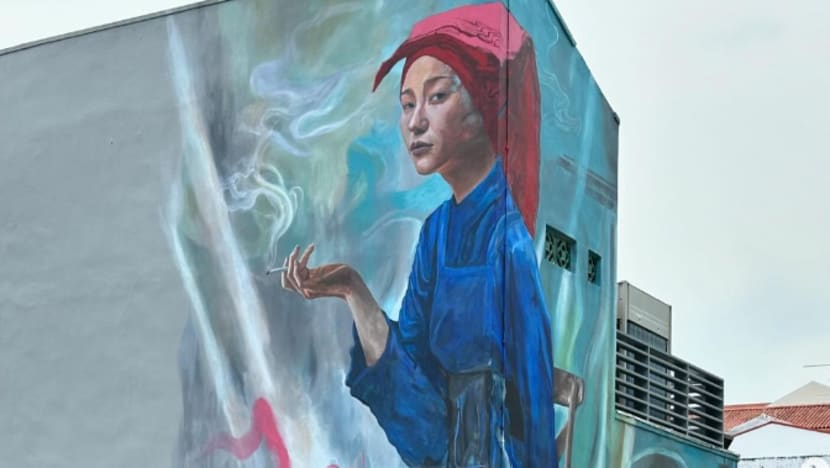URA to re-evaluate stance over Chinatown mural featuring smoking samsui woman after public feedback

URA is re-evaluating its stance on the Chinatown shophouse mural following recent public feedback. (Photo: Instagram/seanpdunston)

This audio is generated by an AI tool.
SINGAPORE: The Urban Redevelopment Authority (URA) is re-evaluating its position over a Chinatown shophouse mural depicting a young samsui woman smoking, due to recent public feedback.
The authority had earlier given the landlord a deadline to erase the cigarette from the artwork.
In response to CNA's queries on Saturday (Jun 22), URA said that all proposals for murals on conserved buildings must be submitted to both the building owner and URA for approval before works can begin.
However, the mural on the conserved shophouse at 297 South Bridge Road was completed without prior approval and URA said it had informed the building owner to submit the mural proposal for assessment.
"After consultation with local stakeholders and relevant agencies, the proposal was not supported as the depiction of smoking on the unauthorised mural is not aligned with Singapore’s anti-smoking policy," said URA.
"In light of recent public feedback, URA is re-evaluating its stance on the mural."
The mural's artist Sean Dunston told CNA he was thankful that URA was taking another look at its decision, and he hopes that the authority will allow the mural to remain as it is now.
He referenced an email from the authority asking the landlord to delay any work on the mural until its review is completed.
"It’s important that the public feedback (URA uses) to regulate images seen in public be more even-handed (or at least less offensive than the art it’s criticising) and that enforcement of policy regarding art, in particular, be more nuanced and geared towards supporting art and discussion," he said in response to queries.
Murals on shophouses
Singapore is home to more than 6,500 conserved shophouses, built between the early 1800s and mid-1900s.
While many have been adapted to new uses, it is important that works to them do not change their architecture, according to guidelines published by URA in 2022.
Murals are allowed on end gable walls of shophouses and must be “appropriate to the character of the area”.
“They should not contain profanity, negative racial or religious implications,” URA said, adding that murals at other parts of a conserved building can be considered but are subject to evaluation.
Permission must be sought before murals are painted on any conserved building. These come under Category 3 works, described by URA on its website as "minimal and localised" work.
The application does not need to be made by a qualified person - such as a registered architect or professional engineer - and can be made by owners and contractors.
A Category 3 application requires a letter of authorisation by the owner of the building, as well as a proposal for the work, such as a colour photo or floor plans and elevations. The application is free.
URA said on its website that applicants can expect a reply within 10 working days.
If the proposal is in order, URA will issue permission for the work. No work can be carried out before this permission is given.
After the work is completed, photographs of it need to be submitted to URA. If everything is in order, the authority will issue a letter for endorsement of completed works.
Other types of work may fall under Category 1 or 2.
Category 1 works affect key elements and "have a significant impact on the architectural character and spatial integrity" of the buildings. Applications for such works need to be made by a registered architect.
Category 2 works affect key elements "to a lesser extent". Applications must be made by a registered architect or a professional engineer.
Besides the painting of murals, other types of Category 3 works include the addition or repositioning of business signs and the installation of air-conditioners and solar panels.
The initial order by URA to erase the cigarette came to light after Mr Dunston highlighted the incident on Instagram two days ago, sparking plenty of debate and discussion online.
His post went viral, garnering more than 3,000 likes as of Saturday morning, with many people leaving comments supportive of his work.
The artist wrote in the post that he was told to "get rid of the cigarette" by Jul 3 and that he was "thinking of alternatives that would be acceptable to URA".
He also said that he was told by URA that it had received feedback on the mural from a member of public, who found the mural "offensive" and "disrespectful" to samsui women.
The person also said that the woman depicted in the mural "looked more like a prostitute than a hardworking samsui woman".
LANDLORD'S RESPONSE
While "heartbroken" by URA's initial order to revise the mural, both the landlord of 297 South Bridge Road and Mr Dunston will respect and comply with the government agency's final decision, the landlord's representative, Shepherd Asset Management, told CNA.
URA informed the landlord on Friday night - the day the debate over the mural first appeared in the public sphere - that it would re-evaluate its stance.
"We commissioned the mural design with the intention to depict an uncensored and unique perspective of the hardworking Samsui woman," said a spokesperson for Shepherd Asset Management.
"We are heartened by the recent outpour of public support for our mural, and we hope that our mural can continue to serve as a poignant reminder of the challenges faced by the Samsui women and their invaluable contributions they made to Singapore's early development."












